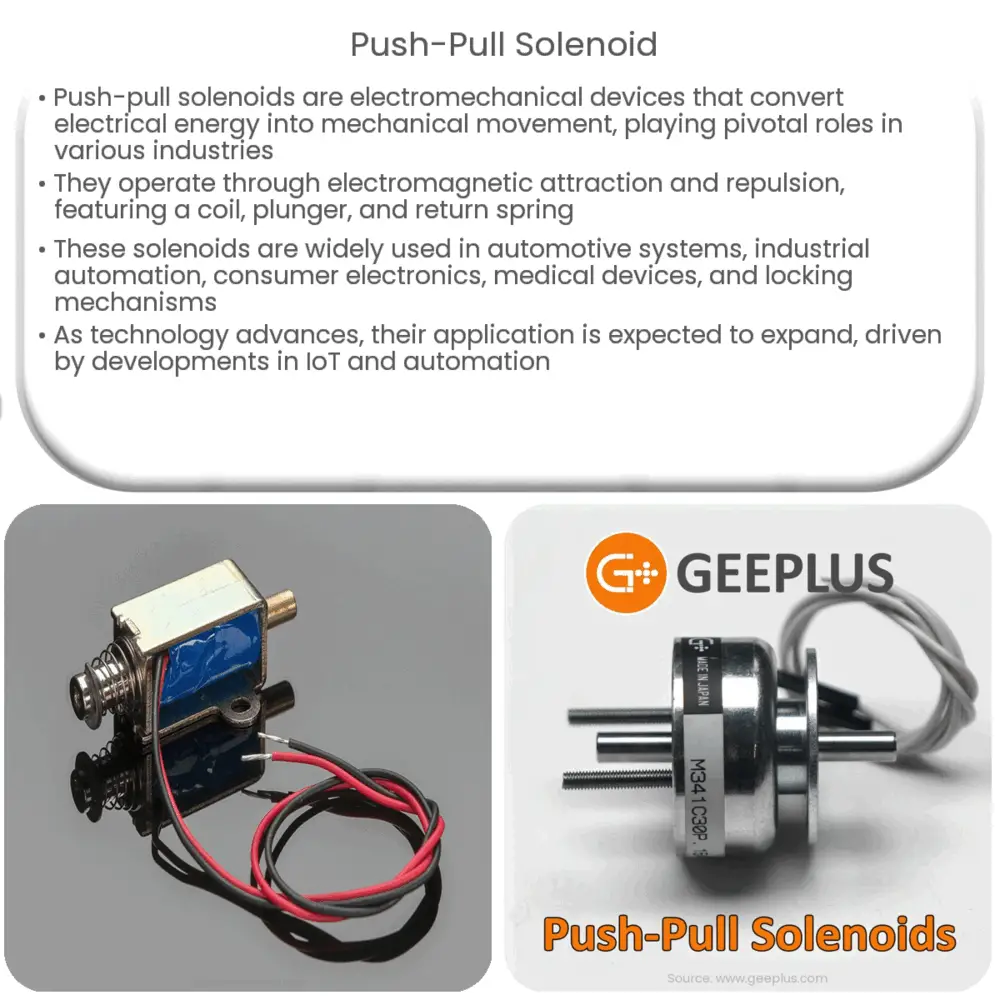Explore the workings, applications, and future of push-pull solenoids, crucial components in electromechanical systems.

Introduction to Push-Pull Solenoids
Push-Pull Solenoids, a subset of electromechanical devices, are a fundamental component in various applications across many industries. From door locks and printers to vending machines and car automation systems, these solenoids contribute significantly to the seamless operation of these devices.
Understanding the Push-Pull Solenoid
The push-pull solenoid, as the name suggests, operates based on the concept of electromagnetic attraction and repulsion. When an electrical current passes through the coil of the solenoid, it generates a magnetic field. This magnetic field subsequently induces a mechanical force on a movable plunger, causing it to move in the direction of the magnetic field, thereby ‘pushing’ or ‘pulling’ as required.
- Push Action: The solenoid ‘pushes’ when the plunger is extended out of the solenoid body under the influence of the magnetic field.
- Pull Action: Conversely, the solenoid ‘pulls’ when the plunger is drawn into the solenoid body due to the magnetic field.
Construction and Working Principle
Push-pull solenoids consist of three primary components – a coil, a plunger, and a return spring. The coil, typically made of copper wire, is wound around a bobbin, forming the body of the solenoid. The plunger, usually composed of ferromagnetic material, is positioned within the coil, ready to move under the influence of the magnetic field. The return spring, on the other hand, is responsible for returning the plunger to its original position once the electric current is turned off.
When an electric current flows through the coil, it creates a magnetic field. This magnetic field induces a force on the plunger, causing it to move. If the magnetic field is aligned such that it pulls the plunger into the coil, it is termed as the ‘pull’ action. Conversely, if the magnetic field pushes the plunger out of the coil, it’s the ‘push’ action. The return spring, located at the opposite end of the plunger, pushes the plunger back to its original position when the current is turned off, thus resetting the solenoid for the next operation.
Applications of Push-Pull Solenoids
The versatility of push-pull solenoids makes them suitable for a plethora of applications. Some of the most common uses include:
- Automotive Systems: In vehicles, push-pull solenoids are commonly used in automatic door locks, automatic gear shifters, and starter systems.
- Industrial Automation: These solenoids find extensive application in conveyor systems, robotics, and other automated machinery, where they control various mechanical movements.
- Consumer Electronics: In devices like printers, cameras, and vending machines, push-pull solenoids are used to control various mechanical actions such as paper feeding, lens focusing, or dispensing products.
- Medical Devices: These solenoids find use in various medical equipment like ventilators and drug delivery systems where precise control of mechanical movement is crucial.
- Locking Mechanisms: From security doors to safes, push-pull solenoids are a popular choice for electronic locking systems due to their reliability and compact size.
The Future of Push-Pull Solenoids
The future of push-pull solenoids looks promising, with advancements in material science and electromagnetics expected to result in more efficient and compact designs. In particular, the rise of IoT (Internet of Things) and automation technologies is anticipated to drive demand for these versatile components, as they offer a simple and effective solution for converting electrical energy into mechanical movement.
Considerations When Choosing a Push-Pull Solenoid
While push-pull solenoids offer numerous benefits, it’s essential to select the right solenoid for your specific application. Key considerations include the required force, stroke length, power requirements, operating temperature, and environmental conditions. In addition, the size and form factor of the solenoid may also be crucial, particularly in applications where space is limited.
Conclusion
Push-pull solenoids are an integral part of many everyday devices, converting electrical energy into mechanical movement to perform a variety of tasks. Their compact size, versatility, and reliability make them a popular choice for a wide range of applications, from automotive systems and industrial machinery to consumer electronics and medical devices. As technology continues to advance, the use of push-pull solenoids is expected to grow, offering exciting possibilities for the future of automation and electromechanical devices. Whether you are a product designer, engineer, or simply someone interested in how things work, understanding the workings of push-pull solenoids offers a glimpse into the fascinating world of electromechanical systems.

